This year is the centenary of the outbreak of the First World War. It is also the centenary of a remarkable sequences of events which occurred in small pockets all along the Western Front over several days, now known to history as the
Christmas Day Truce of 1914.
During recent weeks, in Britain, there has been heated debates across social media about a 2014 Christmas advert which is a reenactment of this famous truce. The general consensus appears to be that the advert itself has been well acted and well staged. However, it is of great discomfort to many people (myself included) because the reenactment is an advert. And an advert for one of Britain's largest grocery shops, and so is distasteful because of its blatant commercialisation of a tragic event. With the advert playing virtually every day in Britain since mid-November, it prompted me to do my own research on the Christmas Day Truce to determine what had actually happened. Thus was the background to my post today - to discover the truth behind the Christmas Day Truce.
My primary sources are the many local and national British newspapers digitally preserved and kept by the excellent archive,
British Newspaper Archive. Rather then retell the story in my words, I thought it best if you read the newspapers of the time to see what had actually occurred throughout December 1914. As there are so many newspaper cuttings in my post, I haven't transcribed them. The quality of some of the print is poor, but I do recommend that you persevere with reading them, as this is a remarkable story. Use your computer's controls to zoom into each article.
So that you can make up your own mind about the events, I have only written a brief commentary on the newspaper articles. Whilst you read each article, remember that these were contemporary reports written at the very height of the "war to end all wars" so you have to use your own intellect to determine the
unwitting testimony, hidden meanings, and motivation behind each newspaper's report.
Pope Benedict XV tries to secure 12-hour Christmas truce
In early December 1914, Pope Benedict XV tried to secure a 12-hour Christmas truce on all sides. Throughout the length and breadth of Britain, newspapers reported his attempts - below are two of the many reports - one from Scotland, and the other from England.
 |
| Aberdeen Journal - Wednesday 09 December 1914 |
 |
| Western Mail - Wednesday 09 December 1914 |
By the 11th December, newspapers were reporting that Germany was willing to have a truce. America, at that stage not at war with anyone, tried to introduce a resolution into the Senate that the truce should be 20 days (I wonder how on earth Senator Kenyon could possibly think that a truce could last 20 days!!). The reports of a Christmas truce during the Franco-Prussian War of the 1870s was also reported.
 |
| Birmingham Daily Mail - Friday 11 December 1914 |
 |
| Birmingham Daily Mail - Friday 11 December 1914 |
Failure of the Pope's truce
However, by the 12th, the Pope's attempt had failed.
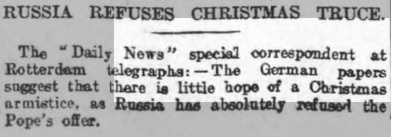 |
| Birmingham Daily Post - Saturday 12 December 1914 |
 |
| Sunday Post - Sunday 13 December 1914 |
 |
| Exeter and Plymouth Gazette - Monday 14 December 1914 |
Of the many newspaper reports I read from these few days in December, none directly confronted Russia for opposing the truce. But only one newspaper mentioned (the glaringly obvious) reason why Russia had declined - and even then, that report wasn't printed until days after the original articles about a potential truce. The absence of the reason for Russia's refusal in the majority reports shows unwitting testimony that the allies didn't always see eye-to-eye on matters of the war. Also notable is the fact that I could not find a single newspaper report which stated Britain's view on the Pope's truce. From looking at just newspaper reports alone, it is very hard to determine Britain's stance - maybe the British government did have a firm view, but the newspapers were ordered not to print it. Or maybe, the government (once again) refused to declare one way or another - a repeat of their failure to commit in June/July 1914 following the assassination in Sarajevo.
 |
| Birmingham Gazette - Monday 21 December 1914 |
Christmas Day reports from the trenches
The Pope's attempts to hold a truce proved to be a failure and the war rolled on. Christmas Day 1914 was on a Friday - despite the bank holidays on Christmas Day and Boxing Day being on a Saturday, newspapers still continued to be printed and rolled off their presses to be read by an eager nation.
The newspapers on Christmas Day and Boxing Day all reported... Well, nothing. Apart from the duplicity of the Germans.
 |
| Western Gazette - Friday 25 December 1914 |
At this early stage, news of any truce in the trenches had not filtered back to Britain. Instead, even on 26th December, newspapers were still lamenting the failure of the Pope's attempt to secure a truce after he addressed his Cardinals in Rome on Christmas Eve. On Monday 28th December, newspapers were reporting that there had been a hard frost and a winter's mist on Christmas morning but hostilities continued. Many of these early reports of Christmas Day in the trenches read much the same as below's report:
 |
| Nottingham Evening Post - Monday 28 December 1914 |
The first reports of the truce filter through
However, by Wednesday 30th December, soldiers' letters had started to be received at home by their loved ones. Many of these letters were sent to the soldier's local newspapers and then filtered through to other local and national newspapers. The story of the Christmas Day Truce had finally reached Britain.
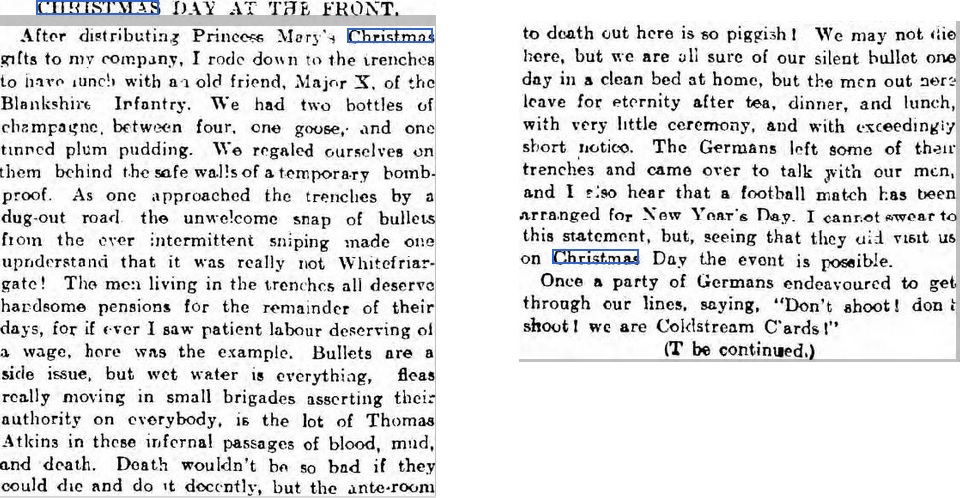 |
| Hull Daily Mail - Wednesday 30 December 1914 |
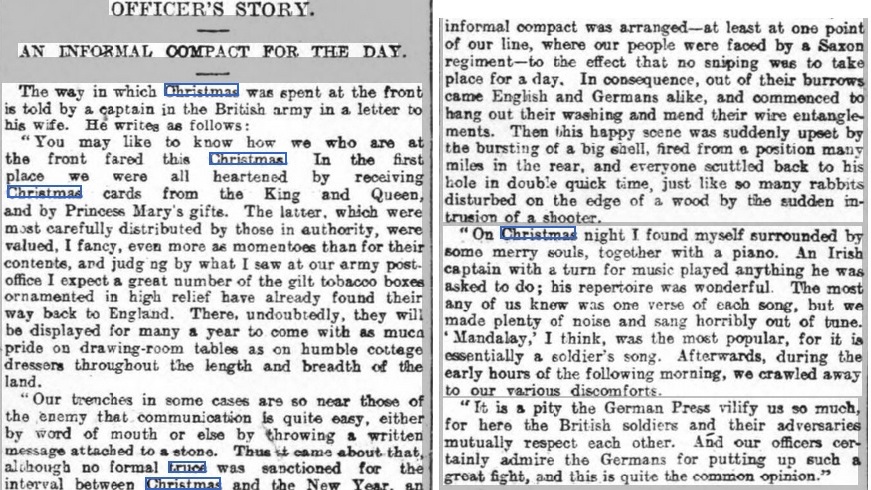 |
| Birmingham Daily Mail - Thursday 31 December 1914 |
 |
| Birmingham Daily Mail - Thursday 31 December 1914 |
 |
| Birmingham Gazette - Thursday 31 December 1914 |
 |
| Birmingham Gazette - Thursday 31 December 1914 |
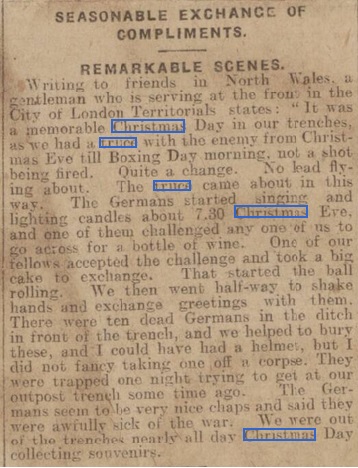 |
| Derby Daily Telegraph - Thursday 31 December 1914 |
 |
| Southern Reporter - Thursday 31 December 1914 |
 |
| Liverpool Daily Post - Thursday 31 December 1914 |
 |
| Aberdeen Journal - Friday 01 January 1915 |
 |
| Nottingham Evening Post - Saturday 02 January 1915 |
 |
| Sunderland Daily Echo and Shipping Gazette - Saturday 02 January 1915 |
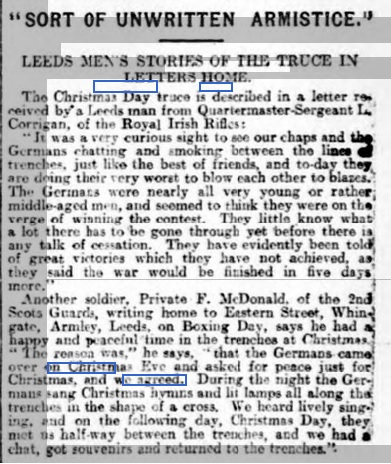 |
| Yorkshire Evening Post - Saturday 02 January 1915 |
 |
| Gloucester Journal - Saturday 02 January 1915 |
 |
| Manchester Courier and Lancashire General Advertiser - Monday 04 January 1915 |
 |
| Manchester Courier and Lancashire General Advertiser - Monday 04 January 1915-Part 1 |
 |
| Manchester Courier and Lancashire General Advertiser - Monday 04 January 1915-Part 2 |
 |
| Manchester Courier and Lancashire General Advertiser - Monday 04 January 1915-Part 3 |
 |
| Daily Record - Tuesday 05 January 1915 |
Western Front Casualties Christmas 1914
The Christmas Truce was a remarkable event of the First World. Even though the Pope was not successful in arranging a formal truce, the soldiers themselves achieved what generals, politicians and religious leaders could not. The varying stories in different newspapers shows that this was not a uniform truce with a set beginning and a set end. Rather, each sector of the Western Front had their own version of the truce - some only allowing the burial of the dead on Christmas morning before hostilities recommenced, whilst other sectors held their truce throughout the entire festive period.
But did the Christmas Truce work? Did it stop some of the carnage on the Western Front?
There is one way that the success of the Christmas Truce can be quantified with hard data - the number of casualties on the Western Front during Christmas 1914. Using the excellent
Commonwealth War Grave Commission's website, I interrogated the number of United Kingdom casualties each day for Belgium and France during the later part of December 1914 and early January 1915. The graph below clearly shows a dip in casualties over the Christmas period.
The Commonwealth War Graves Commission data makes no distinction between whether a man was killed in action, or if he had died of his wounds days after injury. Therefore it cannot be determined how many of the 50 deaths in France and 22 in Belgium on Christmas Day happened because of direct actions on that day, or if the men had died of wounds received days earlier. Local newspapers in Britain did report news of deaths on Christmas day - such as the report below.
 |
| Gloucester Journal - Saturday 09 January 1915 |
The peak of casualties before Christmas can be attributed to the Battle of Givenchy which had raged between 18-22 December. This accounts for the massive number of dead in the pre-Christmas period. Indeed, some Great War commentators have remarked that the Christmas Truce had to happen so that the dead from this battle could be buried, as many of the men had died in no-man's-land and water-filled craters. Their bodies, by that stage, decaying in a terrible state in between the front lines.
Aftermath - Christmas 1915
Throughout the beginning part of January 1915, British newspapers recounted many tales from soldiers who had taken part in the Christmas truce. By mid January, the newspapers were terming it "
the unofficial truce" and by late January "
the famous Christmas truce". As the war rolled on, the Christmas Truce passed into legend and little mention was made of it in newspapers from late February onwards. By 29th November 1915, the newspapers started to report that Pope Benedict XV was, once again, trying to arrange Christmas Truce. But this time, he had narrowed his scope, and the truce was to be between "
Catholic orthodox countries". The Pope's previous year's attempt at world peace between all the various religions of the combatant nations had obviously proved to be insurmountable. However, this too failed and newspapers seem to have simply stopped reporting the Pope's truce by early December 1915.
A few days before Christmas 1915, some newspapers started to question if there would be another truce for that Christmas. But the mood of Britain had changed: 1915 had brought the sinking of the passenger ship the Lusitania, killing 1,195 passengers - many of whom were women and children; along with the execution of nurse Edith Cavell. The newspaper report below sums up the mood:
 |
| Edinburgh Evening News - Tuesday 21 December 1915 |
Other newspapers were more explicit in stating that there would be no truce
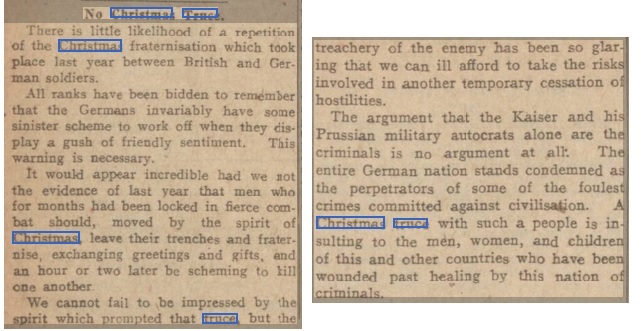 |
| Dundee Courier - Thursday 23 December 1915 |
 |
| Derby Daily Telegraph - Friday 24 December 1915 |
In 1915, there was no Christmas truce and the war rolled on to the bitter end with no further truces...
Or did it?
Christmas Truce 1916
In my research for writing this post, it occurred to be that a couple of years ago I had purchased from that well known internet auction site a Christmas postcard from 1916. When I bought it, I was intrigued by its message as it implied that something strange had happened in the trenches in 1916. Was there a truce in 1916? I could not find anything in the
British Newspaper Archive which states that there was one. But maybe there was one.
 |
France 25 December 1916:
The flag we are willing to sacrifice our lives for in order that they may continue to float over free peoples. What a tale I will have to tell you all of later of a Xmas day in the trenches.
Fred |
I wonder what remarkable tale of Christmas 1916 in the trenches Fred had to tell when he got home? Was it as remarkable as the Christmas Truce of 1914?
 |
| German soldiers of the 134th Saxon Regiment and British soldiers of the Royal Warwickshire Regiment, 26 December 1914 |
 |
| British and German troops meeting in no man's land, Christmas 1914 |
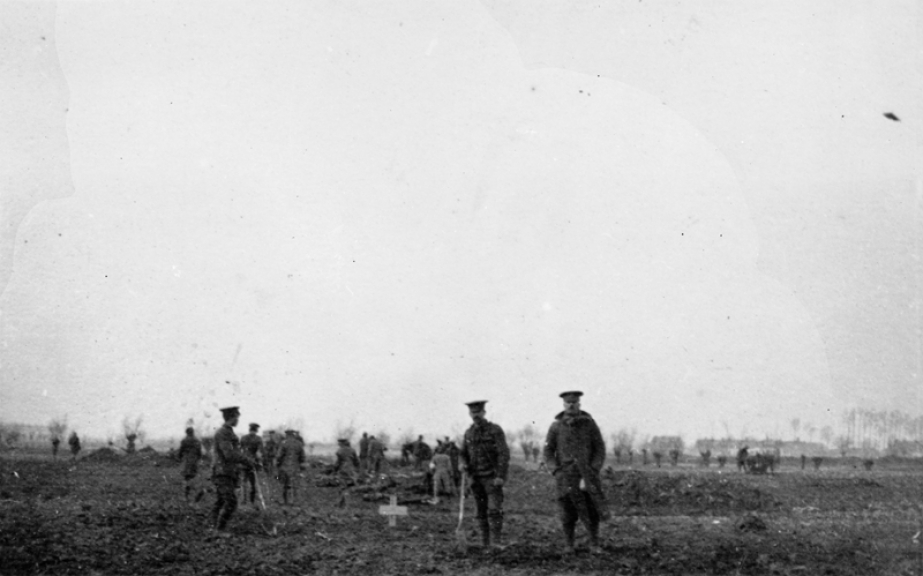 |
| Christmas 1914 - burying the dead from both sides |
 |
| Daily Mirror - Friday 08 January 1915 |
 |
| British and German officers in no-man's land - Christmas 1914 |
 |
| Soldiers fraternising in Belguim on Christmas Day 1914 |
You may be interested in
-
Imperial War Museum podcast: Christmas Truce
-
Imperial War Museum podcast: Christmas during the Great War
-
BBC Radio 4 broadcast: Voices of the Great War - The Christmas Truce
(the above include some incredible oral recordings from soldiers who took part in the truce)
-
First World War Centenary Partnership
(the above links to a site which details several events going on throughout the Christmas period in Britain, to celebrate the centenary of the Christmas Truce)
*_*_*_*_*_*_*_*_*_*_*_*_*_*
My Christmas Advent Calendar 2014
Throughout December 2014, I have been running a daily Christmas Advent Calendar with a door to open which reveals a website of historical interest. Please do take a peek at my calendar.
To all readers of this blog, happy Christmas
*_*_*_*_*_*_*_*_*_*_*_*_*_*
I look forward to sharing with you more of my discoveries over the coming months - see you next time on this blog on 18th January 2015. In the meantime, you can catch me on my blog
Essex Voices Past or on twitter @EssexVoicesPast
You may also be interested in my previous posts on this blog
-
November 2014: Men (and women) of courage
-
October 2014: Writing local history
-
September 2014: Hidden from history - the scandalous Redit women of Suffolk
-
April 2014: Happy Easter 1916?
-
March 2014: Who do you think they were?
-
February 2014: Family History Show and Tell
-
January 2014: Family history is like a box of chocolates - you never know what you're gonna get
©
Essex Voices Past






























































